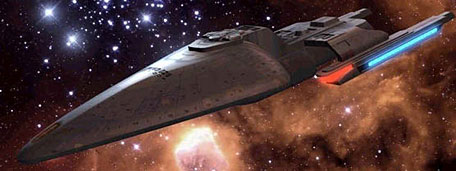
USS ARK ROYAL SPECIFICATIONS
Registry Information
Class:
Quantum
Type: Enhanced Deterence Explorer (Battlecruiser)
Registration: NCC-74133
Built: Andor Fleet Yards, Andor Orbit
Commissioned: Stardate 51069.05
Primary Mission: Defence of the Federation
Secondary Missions: Exploration, Diplomatic
and Ambassadorial
Commanding Officer: Captain Alexandria
Francis
Refit / Resupply Information
Time Between Resupply: 1 years
Scheduled Refit (minor): 5 years
Scheduled Refit (major): 20 years
Expected Service Life: 50 years
General Specifications
Length:
1020 meters
Width: 360
meters
Height:
120.81 meters
Number of Decks: 37
Crew Compliment: 1750
Maximum Rated Occupancy: 16,000 maximum rated for installed life support system
Computer Systems
Positronic/Bio-Neural Hybrid
Command Circuitry Matrix: LCARS Mark
V
Data Transfer Rate: 55 megaquads per second
Dedicated Modules: 3600
Storage Capacity: 131.8 quadrillion bits per Module
Communications Network
Intraship Transmissions: Voice and Data
Ship to Ground Range: 60,000 to 120,000 km
Data Transmission Rate: 18.5 kiloquads per second
Subspace Speed: 214 trillion kilometers per hour (22.8 light-years)
Sensor Systems
High Resolution Scan: 5 Light Years
Medium to Low Resolution: 20 Light Years
Lateral Sensor Array: 1.5 Light Years
Navigational Arrays: 1 Primary, 1 Auxiliary (saucer section)
Starfleet Series Scientific Probes: 25
Warp Propulsion Systems
Quantum Gravitic Reactor: 1
Normal Cruise: Warp 8.3 for one year
Maximum Cruise: Warp 9.999975 up to 6 months
Maximum Rated: Warp 9.99999 for 36 hours
MARA (Emergency use only): 1
Normal Cruise: Warp 8
Maximum Cruise: Warp 9.9
Maximum Rated: Warp 9.99 for 36 hours
Impulse Propulsion Systems
Granivox Fusion Impulse Drives (Stardrive):
6
Granivox Fusion Impulse Drives (Saucer):
2
Normal Cruise Speed: 270 million km per hour.
Suggested Maximum Speed: 500 million km per hour.
Maximum Speed Possible: 750 million km per hour.
Tactical Systems
Type V Burst Fire Photon Torpedo
Tubes: 6 Maximum Spread:, 12 round bursts
each.
Primary Loadout: 500 Quantum Torpedoes
Secondary Loadout: 400 Photon Torpedoes
Tertiary Loadout: 100 Transphasic Torpedoes
Type XV Phasers Quantum Phase
Enhanced: 18
Firing Arc: 18- 360 degree firing radius
Range:
567,000km
Power Output: 10,625 terrawatts each
Quantum Resonance Cannon (located at the front of the saucer section. Takes up 4
decks): 1
Range:
500,000km
Total Output: 5.02 billion terrawatts
NOTE:
This requires the use of all the ships available power, except life
support. After it's use the ship requires
sixty seconds for power to return to all of her systems. During
power up and recharge the Ark Royal is completely
defenseless.
Pulse Phaser Cannons type III: 4
Range:
375,000
Power Output: 50,000 terrawatts each
Ion Pulse Cannons: 3
Range:
300,000km
Power Output: Special
Anti-matter Spread Emitter
Deflector Shields (First Generation
Trans-spatial): This new shielding
system builds a back-buffer shield in addition to the primary shield.
When sufficient damage is taken to the primary shield, the back
buffer is phased through to replace the primary while it regenerates
within the protection of the new primary shield. This new system
consumes a good deal of energy, which is supplied by half a dozen
fusion reactors arrayed near the shield emitters. The new shields
also incorperate every advancement Starfleet has made in the last
20 years (ie. Auto modulating, Meta-phasic shielding, Regenerative,
and Multi-Spatial shielding technology)
Total Output Capacity: 6.9 million terrajoules
Embarked Craft
Shuttlebay 1: 12 shuttlecraft, 3 cargo shuttles, 5 Yellowstone Class runabouts
Shuttlebay 2: 12 shuttlepods, 4 Sphynx class workbees
Fighterbay: 12 Federation Fighters
ADDITIONAL INFORMATION
Heavy Duranium/Tritanium Double Hull plus 18 cm of layered armor.
Like The Galaxy Class ships before it, the Quantum Class starships
are capable of seperating and reconnecting it's Saucer from its
Stardrive section.
Ablative Armor (Prototype Armor Generation
System): Ablative armor hull plating
has been in development for a number of years, though various factor
related to materials availability, instabilities, phaser and torpedo
resistance, and long fabrication lead times have prevented its widespread
use on front line starships. The armor worked in two stages; in
the event of shield-envelope disruption, phaser or thermal EM is
first dissipated over the hull surface, and above an undisclosed
threshold causes the molecular matrix to boil off at a controlled
rate, carrying away a large fraction of the landed beam energy.
In most cases the boil-off created a medium density particle cloud,
which may help disperse the incoming beam. The U.S.S. Defiant was
the first starship to be equipped with ablative armor. As a result
of it's successful field use against Dominion, Klingon, even Federation
weapons. As a result Starfleet command ordered all newly constructed
ships to be outfitted with the ablative armor. Ablative armor technology
remained fairly unchanged until 2377 when the U.S.S. Voyager returned
from the Delta Quadrant with a new form of Ablative armor that was
acquired from the future.
This new armor is very different from the original. For starters,
the new armor is no longer simply layered on the hull of the ship
during the final stages of construction. The new armor came from
the late 24th century, it is a product Transporter and Replicator
technology. The armor is generated by generators located on the
ship's hull. The new armor uses photons to establish a shield matrix
around the ship and solidifies becoming quite literally a second
skin. This second skin is stronger then any alloy that the Federation
has ever created, and is extremely resistant to directed energy
beams (this includes transporters and tractor beams). The Ablative
Armor is capable of absorbing up to 80% of all energy directed at
it.
Transverse Bulkheads: After the first Serniam attack the Ark Royal and several other
of the ships assigned to Proxima Five had a series of bulk heads
above the power conduits. These bulk heads would contain shielded
replacement conduits. In the event that a conduit is damaged, the
flow of power would be discountinued, then the damaged section would
be jettisoned and the replacement would be lowered into place and
power can once again be restored to those vital systems.
DISPOSITION OF SISTER SHIPS
U.S.S. Quantum, NCC-74132: Post-upgrade shakedown cruise
U.S.S. Atlas, NCC-74134: Destroyed by Breen forces
U.S.S. Heracles: Project suspended
DECK
PLANS